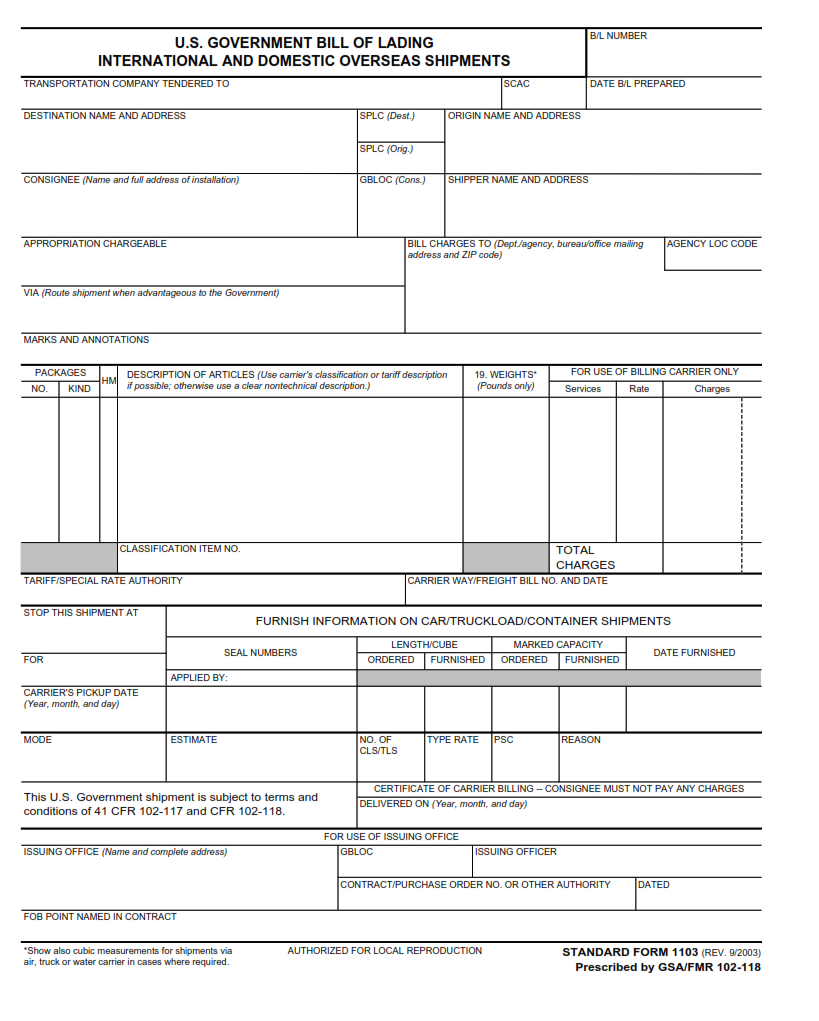SFFORMS.COM – SF 1103 Form – U. S. Government Bill of Lading – The SF 1103 Form, or the U.S. Government Bill of Lading, is a critical document used by the U.S. government and its contractors to track and manage shipments of goods. This form serves as an official receipt for the shipment of supplies, equipment, or materials between different government agencies or from a supplier to a government agency.
Download SF 1103 Form – U. S. Government Bill of Lading
| Form Number | SF 1103 Form |
| Form Title | U. S. Government Bill of Lading |
| File Size | 309 KB |
| Date | 09/2003 |
What is a SF 1103 Form?
The SF 1103 form is a U.S. Government Bill of Lading, also known as a GBL. This form is used by government agencies to document the transportation of goods and materials from one location to another. It serves as a receipt for the shipment and provides information about the contents, weight, and destination of the cargo.
The GBL is issued by various government agencies such as the Department of Defense, Department of Agriculture, and Department of State. It is often required for shipments that involve military equipment or other sensitive materials.
To fill out an SF 1103 form, you will need to provide detailed information about the shipment including the name and address of both the shipper and receiver, description of items being shipped, weight or volume measurements, mode(s) of transportation used (e.g., air freight or ground shipping), and any special instructions or handling requirements. Once completed, it must be signed by both parties involved in the shipment.
What is the Purpose of SF 1103 Form?
The SF 1103 Form, also known as the U.S. Government Bill of Lading, serves as a legal document used by government agencies to ship and receive goods. This form is essential for tracking shipments between government locations and contractors. The information provided on the form includes the name and address of the shipper, consignee, and carrier, as well as details about the shipment’s contents.
The purpose of this form is to ensure that all government-owned or contracted items are properly documented during transportation. It also helps to prevent loss or damage during transit by providing a clear chain of custody for each shipment. Additionally, it provides a record-keeping mechanism for accounting purposes and enables tracking of shipments in case issues arise during transport.
Overall, the SF 1103 Form plays an important role in ensuring that government property is transported efficiently and effectively while maintaining accountability throughout its journey from origin to destination.
Where Can I Find a SF 1103 Form?
The SF 1103 form is a crucial document for the U.S. government as it acts as a bill of lading for official shipments. It contains important details such as the date of shipment, destination, and contents of the shipment. If you are looking to fill out this form, there are several ways you can access it.
Firstly, you can visit your local U.S. government office and request a copy of the form in person. Alternatively, you can download the form from various websites online such as the General Services Administration website or through various shipping companies that offer government shipping services.
It is important to ensure that when filling out this form, all information provided is accurate and complete to avoid any issues during transportation and delivery. Additionally, it is recommended to consult with an expert if there are any questions or uncertainties regarding the completion of this document.
SF 1103 Form – U. S. Government Bill of Lading
The SF 1103 Form, also known as the U.S. Government Bill of Lading, is a legal document used to authorize and record the shipment of goods by the U.S. government or its agencies. It serves as both a receipt for the carrier and an agreement between the shipper and receiver regarding delivery terms and conditions.
One of the main purposes of using SF 1103 is to ensure compliance with regulations for government shipments. The form includes specific instructions on how to complete it, including information about packaging requirements, hazardous materials, and special handling instructions.
Moreover, SF 1103 provides clear documentation that can be used to track shipments from start to finish. This helps prevent loss or damage during transit and ensures accountability for all parties involved in the shipping process. Ultimately, using this form allows for greater efficiency and transparency when transporting goods on behalf of the U.S. government or its agencies.
SF 1103 Form Example
